Had a Lot of Fun at SaltCon 2016

This past weekend I joined in with 1,124 others to play a ton of board games at SaltCon 2016.
The board game convention, SaltCon was held this past Thursday, Friday, and Saturday and I was happy I could attend all 3 days this year. I made sure to get the time off work as well as the time away from home. That way I could completely immerse myself in the fun and play as late as I wanted every night.
Now that I’ve rested up a bit, it’s time to look back on all the fun.
While I had a goal to play 30 different games this year, I was really most interested in having a great experience. I wasn’t interested in playing short games just to hit the 30 mark. Instead, I wanted to dig into games that might take longer to play, but felt more fulfilling.
And in that regard, I say “mission accomplished”!
THE PEOPLE
I also knew I’d spend a lot of time catching up with the many great people I’ve met at previous SaltCons. Rather than fill every moment playing, I also enjoyed visiting with friends — both old and new.
It really was a blast to meet so many people that I can now call friends.
Because that’s what happens when you sit down and play games together — you become friends!
THE GAMES

In total, I played 27 different games with a lot of very nice people. Only 3 of the games were ones we’ve reviewed previously. And 2 of the games were expansions to games I’ve enjoyed playing before. Which means I played 22 new-to-me games.
Leading up to SaltCon, I made a list of games I most wanted to play. And by the time I left, I was happy to have played most of the games on that list.
I may have only gotten 9 hours total sleep over those 3 days, but I left with a big smile on my face and my sights already set on next year.
Now on to my thoughts (mini-reviews) about each of the games I played.
27 Different Games Played
Since 27 is a lot of games to learn and play (and write about), I’ll break these mini-reviews into 3 posts — one per day of the con.
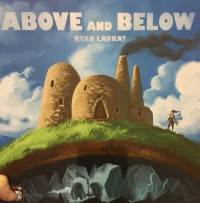
Here’s the rundown of the games (Day 1: 1-7, Day 2: 8-18, Day 3: 19-27).
- Above and Below
- Mow Money
- T.I.M.E. Stories
- Machi Koro: Harbor Expansion
- Ponzi Scheme
- The Game
- God Dice
- Flick ‘Em Up
- The Voyages of Marco Polo
- Power Grid: Australia
- Blood Rage
- Isle of Skye
- Longhorn
- Medieval Academy
- Forbidden Desert
- Metropolys
- Chicago Express
- Gold West
- Cities
- Gravwell
- Stockpile
- Camel Up
- Abyss
- Infinite City
- Between Two Cities
- Empires at Sea
- Deception: Murder in Hong Kong
1. Above and Below
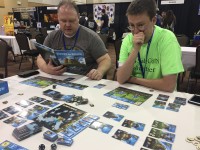
After spending the first hour on Thursday morning setting games out in the Math Trade and Game Swap areas, I headed to the Hot Games area, where I knew I’d find games I’d been wanting to try for a while.
The first game I dove into was Above and Below – a game by local game designer and artist Ryan Laukat. He’s also the founder and president of Red Raven Games.
Above and Below is a creative board game with a storytelling element to it. In the game, players have their own village board and send their villagers to perform jobs like recruiting new villagers, exploring the cave, harvesting resources, and constructing houses. Each villager has unique skills and abilities, and players must decide how to best use them.
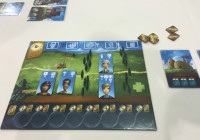
The part I enjoyed the most was sending villagers exploring below. When they’re sent to explore, the player draws a card and rolls a die to determine what adventure will unfold.
Then another player opens a spiral-bound book and reads the story from the corresponding section. The active player then chooses between two options and rolls dice to see how successful they are at that task.
For example, a player may be faced with following a strange creature further down the tunnel, or trying to grab that creature’s bag. Depending on the choice and outcome, the player may gain more goods for their village as well as lose or gain Reputation.
Playing Above and Below with Mike, Scott, and Quince was a fantastic start to SaltCon. We built our villages, enjoyed the stories told and choices made, and overall had a great time playing.
Buy a copy of Above and Below.
2. Mow Money
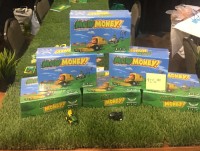
I then stopped by the Mayday Games booth to check out their super cool display of Mow Money. As you might expect, Mow Money is a game about mowing lawns. And in keeping with the theme of the game, Mayday had part of their display, as well as the game table, covered in thick astroturf. It was so cool.
But even more cool than that was sitting down to play the game with the designer, Matt Saunders. He’s a very nice guy and fun to play with. Even though I totally failed with my landscaping business in Mow Money, I was also able to play other games during SaltCon with Matt and he was great to play with every time.
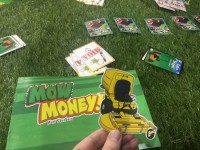
In Mow Money players manage their own landscaping business and bid for jobs to complete in different neighborhoods. Each player is out to become the best landscaper in order to land a major contract with the city. Because the contract will go to the business with the highest reputation at the end of the game.
Each player starts with just a push lawnmower and by investing wisely in better mowers can gain the upper hand in bids for neighborhood jobs.
The bidding aspect in Mow Money is a cool part of the game because players are trying to be the lowest bidder. In most auction games, the reward goes to the highest bid. But not in Mow Money.
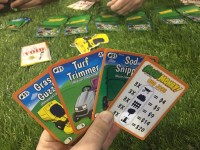
So it’s a tough balance. You have to bid low (using Bid cards of different values) to get the job. But then your reward for a successful bid is that you earn the amount of cash that you bid. However, instead of bidding on a job, you can also perform Odd Jobs by turning in sets of bid cards for different cash values. I didn’t learn the importance of completing Odd Jobs to earn cash until it was too late. Others were on to bigger and better mowers while I was still just trying to scrap by on little cash because of missing out on my bids.
Who knew running a landscape business could be so cutthroat?
But even though I didn’t fare too well, I had a great time playing Mow Money with Matt, Seth, Kris, Jonathan, and Daniel.
You can also see our full review of Mow Money.
3. T.I.M.E. Stories

T.I.M.E. Stories was one of the games I lined up to play before SaltCon ever started. I’ve heard a lot about the game being an “experience” game – meaning that once you’ve played it through, you’re done. Since the game centers on solving a mystery, once you’ve solved it, there isn’t much draw for repeated plays.
I had also heard that the content in the game may not be suitable for a family audience. So rather than get the game for our family, I thought SaltCon would be the perfect place to try it out and see how it fared.
Via a SaltCon thread on BoardGameGeek.com, myself and 3 others determined we’d meet up to play T.I.M.E. Stories at 5:00 pm Thursday. While I was finishing my game of Mow Money, Chris and Julie got the game set up on a nearby table. Since none of us had played before, they also found someone who could teach the mechanics of the game to us.
Unfortunately, the 4th person who was set to play with us was still playing another game in a tournament. Chris spoke with him and he indicated they were almost done, so we waited a bit. After another 15 minutes, he checked again and they were on their last round. So we waited a bit more. Just before 6:00 pm, that player came by and said his buddies were going to dinner earlier than he thought so he wouldn’t be playing with us and to find another player.
AAARRRGGGHHH!
Talk about uncool.
Even though that was a major breach of board game etiquette (and a downer) Chris, Julie and I totally made good on the time to get to know each other a bit better. Yes, we would have liked to have gotten going on the game earlier, but I enjoyed the time talking nonetheless.
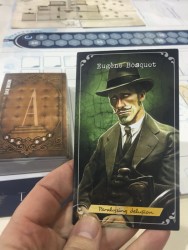
Once we got underway (with Alex joining us), Kenny gave us a good overview of the game and set us loose.
In T.I.M.E. Stories, players have a limited amount of time to solve the mystery. Every action players take (like moving locations or battling) will reduce the time they have left. The good news is that if you run out of time before solving the case, various things will reset and you’ll get to go at it again — with gained knowledge in hand.
Needless to say, we ran out of time on our first run. We went down a few dead ends and learned a few things along the way.
For our 2nd run, we got further along (skipping areas we now knew we didn’t need to go to or characters we didn’t need to talk to). But we still didn’t solve the mystery.
On our third run, we finally got through it all and were relieved to do so. It was an engaging story and a very interesting game. I’m definitely glad I got to play it and enjoyed the company of everyone I played with.
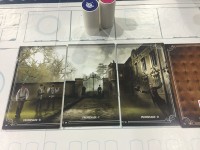
In the end, I think playing T.I.M.E. Stories at a board game convention was a great way to go. I got the game experience in a single play and don’t need to worry about repeated plays.
That being said, they’ve already come out with a new story in the series and a third story was just announced as well. So those who own the game can look forward to additional stories continuing to come out that utilize the base game system.
Without giving away any spoilers however, I will confirm that the warnings about content are warranted. It’s like a PG-13 movie that you leave thinking, “Why did they put that in there? It wasn’t at all necessary to the plot.” So if you’re looking for a family game, don’t get caught up in the T.I.M.E. Stories hype.
By the time we finished T.I.M.E. Stories, it was 9:30 pm and I was hungry. So I took a break to get some fresh air and a quick dinner.
Buy a copy of T.I.M.E. Stories.
4. Machi Koro: Harbor Expansion
After learning a few new games, as well as coming off of a long 3+ hour game, it was time to settle into a familiar game — Machi Koro. Only this time, I’d be playing with a couple game expansions added in: the Machi Koro Harbor and Millionaire’s Row expansions.
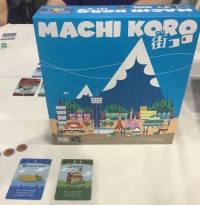
After seeing our recent review of Machi Koro, my SaltCon buddy Doug offered to bring his copy and introduce me to the expansions. The first time I played Machi Koro was at SaltCon 2015. So it seemed only fitting to get in a game of it with expansions this year. Alex introduced me to the game last year and he also joined in with Doug, Leo, and I.
The thing I liked about the expansions (besides adding in a lot of new location cards) was that the set of cards to purchase from the market is variable. Thus, experienced players can’t just go with a set strategy from the standard set of cards. Instead, players have to make the most of what locations come up.
Of course, there is also a downside to this if the first groups of locations cards to surface are high value cards. It means the initial, cash-generating cards aren’t there to help the game get rolling along. Or if they do come up, not everyone gets a chance to get some. And in our case, I snagged up all the red cards whenever they’d surface. So I was getting most of my money from others on their rolls. (They didn’t appreciate that much. Especially Leo.)
But I had a fun time and there was plenty of good-natured trash-talking along the way.
5. Ponzi Scheme
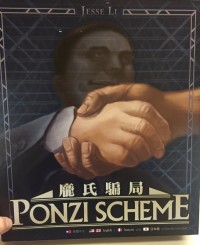
I was then introduced to a new game that has yet to hit US shores — Ponzi Scheme.
Adam had already played it a few times and loved it. So he could hardly wait to introduce it to more players and I was definitely up for it.
In Ponzi Scheme, players are scammers trying to trick investors into funding fraudulent investments with the promise of extremely high returns. Players pick up investments that have ridiculous amounts to pay out when they come due. And the first player to go bankrupt ends the game.
When the game ends, the player with the who forged the biggest shell corporation wins the game.
It’s got some pretty cool game play elements that have you constantly trying to stay afloat.
Not only is there the cycle of when payouts come due. But there’s also an element of insider trading and brokering deals. There’s an envelope included where players can pass bank notes to one another offering to purchase a share. That player can either accept the offer or double the bid and send it back to the original player to take a share from them.
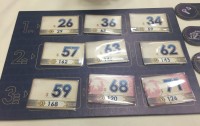
The game continues until at least one player cannot pay the “promised reward” due and goes bankrupt. That player is out of the game, and the remaining player who has the most VP on their Industry wins.
We played a 5-player game of Ponzi Scheme (Adam, Leo, Ryan, Jason, and I) and it was crazy.
Crazy fun.
Leo thought for sure I’d be going bankrupt soon because of when I had investment payouts coming due and made his deals accordingly. So when I made it cleaning past that turn, he was shocked. Shares were traded all over and as more investments piled up, we knew the end was coming.
It turns out that 3 of us went bankrupt on the same turn and a winner was crowned. Then we compared amounts to see who was the most bankrupt — yep it was me.
I hear the game will be coming to America, but I’m not sure when yet. It’s definitely a game I’d like to pick up when it does.
6. The Game
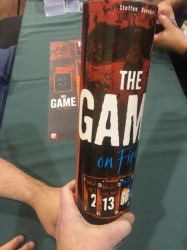
By this time it was past midnight and we had to shuffle over to another area to keep playing games.
With a number of games people had brought to choose from, we ended up playing Ryan’s copy of The Game.
Of course, there were first the obligatory remarks about that being a ridiculous name for a game. And I agree.
But it was actually an interesting, light game. Which was a good game to play late at night.
It’s a cooperative game where players are all trying to discard all 98 cards in the deck into 4 discard piles to win. Two of the discard piles are for cards to be discarded in ascending order. And the other two discard piles are for discarding in descending numerical order.
Each player starts with 6 cards (different number based on number of players) and on a turn, a player must discard at least two cards onto one or more discard piles. Not knowing what cards the other players are holding makes it tough to win.
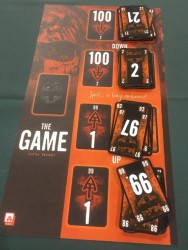
While players can’t say which cards they have, they can make comments about each of the piles. For example, we’d point to a pile and say something like, “I REALLY like this pile.” or “Don’t mess with this pile.” if we had a good card to play there that wouldn’t jump in too many increments.
One cool element is that a player can discard a card exactly 10 higher/lower than the top card of a discard pile even when you would normally have to play in a descending/ascending order. For example, in the pile going down from 100 a player could play a 58 on top of a 48 card to jump it back up to a higher number and give more room to work with.
Once the draw deck is empty, players are only required to play at least one card on a turn.
Our first game of The Game was ugly. It seemed rough right from the get-go and I was booed quite a bit with some of my discards. (A jovial booing of course.)
If you don’t get through all the cards (which is the most common thing to happen) you count up how many cards players have left in their hands to see how well the team did. I think we ended up with 15 combined cards left in our hands.
But we were undaunted and decided to play again.
There were also a few times during the game where the outcome looked bleak. But amazingly enough, in the end we pulled out a complete win by discarding every card! Woohoo!
7. God Dice
At this point, a number of folks were heading out, so Adam pulled out a 2-player game that he and I could play to wrap up Day 1 at SaltCon.
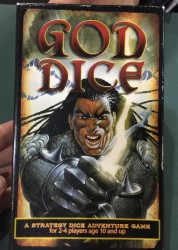
While I don’t care for the name of the game, it was a good game to end the night because it’s just a simple dice-rolling game.
Adam let me know that the way he prefers to play God Dice is a bit different than the rulebook indicates. So in essence we played a variant of the game.
We each had our full set of hero cards in front of us that we’d use to attack the other player. First we’d roll a die that would tell us which character of our was attacking which character of our opponent’s. Then we’d roll the dice to see the outcome.
The dice have different symbols and colors on them and different combinations would be used by different characters to have successful attacks. Thus, after our first roll, we could choose which dice to re-roll in order to perform certain attacks.
It’s really a luck-based game with simple choices of which dice to roll to hope for an optimal attack. And that was fine with me. Because by the time we ended playing it was after 2:00 am and I was ready for some rest.
Overall, it Day 1 was a great start to SaltCon!
Next up…Day 2…(and 11 more mini-reviews)

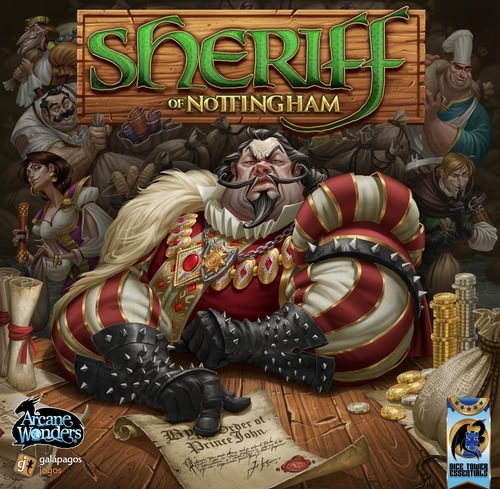
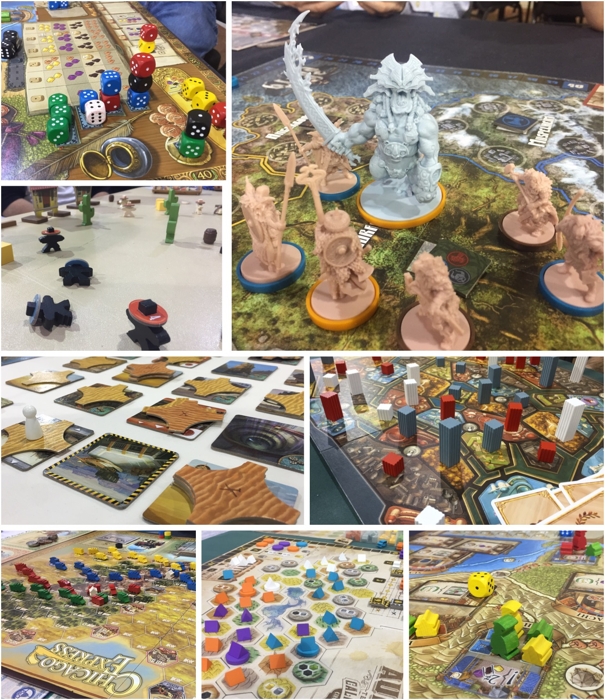
If you enjoy Machi Koro (my wife and I were quite smitten with it once upon a time), you REALLY need to try Valeria: Card Kingdom. I spent my time managing the game library at SaltCon “selling” it to anyone who asked for recommendations. I think it takes all that is good about Machi Koro and then fixes some of the problems while adding a little extra this and that.
Jeff – Thanks for the tip to check out Valeria: Card Kingdom. And thanks for volunteering at the SaltCon game library. That’s a fantastic resource.